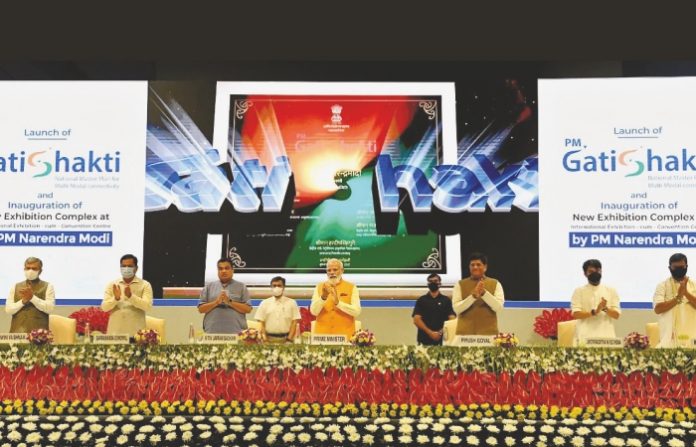Aim of the masterplan is to bring various government departments on a common digital platform, reduce cost of logistics, make business in India more competitive, says Amrit Lal Meena, Special Secy (Logistics), Ministry of Commerce & Industry, Department of Commerce, GOI.
Priyanshi Bana
Prime Minister Narendra Modi announced the launch of the ‘PM Gati Shakti Master Plan’, a 100 lakh-crore project to build ‘holistic infrastructure’ in India, on the country’s 75th Independence Day. The objective behind ‘Gati Shakti’ master plan is to create a common digital platform promising the “integrated planning and coordinated execution” by as many as 16 different ministries. Each ministry and government department will be able to access information about the ongoing and upcoming projects through this platform. The mastrer plan will also help bring together under one common platform the government departments such as railways, roads, highways, telecom and many more. Furthermore, ‘Gati Shakti’ master plan is going to undertake a variety of infrastructural projects under distinct ministries such as Bharatmala, Sagarmala, inland waterways, land ports and UDAN and the like. It will also be assist insetting up various ‘Economic Zones’ at the state levels for improving connectivity and making businesses of the country more competitive as well as bringing down the cost of logistics by a high degree. Elaborating further on Gati Shakti National Master Plan and other related issues, Meena shares various details during a candid conversation with CARGOTALK :
Kindly elaborate in detail about the PM Gati Shakti National Master Plan?
The PM Gati Shakti is a National Master Plan for providing multimodal connectivity for various economic zones in the country. It is an approach for growth, accelerating infrastructure through synchronised, holistic, integrated and comprehensive planning which is based on the knowledge, technology and innovations. The plan provides comprehensive database of the ongoing and the future projects of various ministries, infrastructure ministries, user ministries and also the state governments. More than 300 layers have been mapped based on GIS platform that have been developed by the Bhaskaracharya Institute of Space Applications and Geo Informatics National Institute (BISAG-N). All the ministries and state governments are uploading their respective layers and this information will be available on a common GIS-based platform. Therefore, any ministry wanting to plan any economic zone, or a state government planning to set up an industrial park has to be on the lines of the PM Gati Shakti National Master Plan so that any information required for any kind of clearances is available on this platform to avoid any confusion or uncertainties.
What are the challenges perceived in the execution of this master plan?
In any new concept, challenges are bound to come. One of the main challenges is to build capacities of people involved in the planning of this plan across the concerned ministries and the state governments. This section of people has to be made aware of the execution of the various layers and updating them on concurrent basis. This capacity building, training and motivating people to use it is one challenge, while the zonal and state conferences and institutional linkage through BISAG-N are being planned. A few of such conferences have already been organised in Gandhinagar and Lucknow. Apart from the government officials participating at various levels in these conferences, industry experts at state level too would be invited to make them aware of the infrastructure being created, economic zones developed, clearances required and how they can use this master plan for their planning purposes.
With digitalisation being the base of the PM Gati Shakti Master Plan, do you think digitalisation will play a crucial role in the times to come?
Definitely. It is not only this master plan which is being set up on a single platform. We are also integrating all the digital systems of various ministries and organisations which have a bearing on the logistics. For this, a unified logistic interface platform is being developed as an integrated platform of all the solutions such as Vaahan and Saarthi and the like. Almost 23 such systems are getting integrated through ULIP. The start-up initiative in the logistics sector. We are organising a workshop to apprise them and come out with the use cases useful for people as to how this data can be used to develop solutions for various problems. Process reforms through the use of technology is an essential component of PM Gati Shakti apart from the infrastructure development. Definitely time and cost will be reduced at large with digitalisation.
Two years of pandemic, what necessary steps are being taken to keep logistics sector stay efficient and seamless?
Major component of the logistics is transportation, warehousing, system processing and other admin charges. So the logistics cost is proposed to be reduced by way of intervention in all these components. There are ongoing discussions on the standardisation of the warehouse policy. Many state governments have come out with different warehouse policies. I am sure in times to come things will become further standartised, more use of containerised movement of goods will be promoted, palletisation too will get promoted. All these will add to saving time and cost in future .
Kindly explain National Logistics Policy?
The cost of logistics in India is estimated to be around 13 per cent as compared to the developed nations where it is more than 8 per cent. So this gap of 5 per cent is the biggest challenge. Therefore, the logistic policy is aimed at taking and suggesting measures to reduce the cost and improve the logistics performance of the country compared to the global players. This is the main objective of the Logistics Policy. There has been consultation with the different stakeholders, the user groups, various industry experts and the ministries. It is in its final stages of formulation.
Road logistics sector is on a growth trajectory. What is your take on it?
Road infrastructure in India has become world class under the Bharatmala project. We now have an extensive network of highways and other such various projects. However, according to the policy and expert views, there is a need for modal shift because almost 60 per cent of the goods are being transported through road as compared to the railways which needs to be enhanced. The cost per ton, per kilometre of railways is almost half as compared to the road transportation. Therefore in the policies, there is a mention of promotion of coastal shipping, another cheaper mode of transportation.















